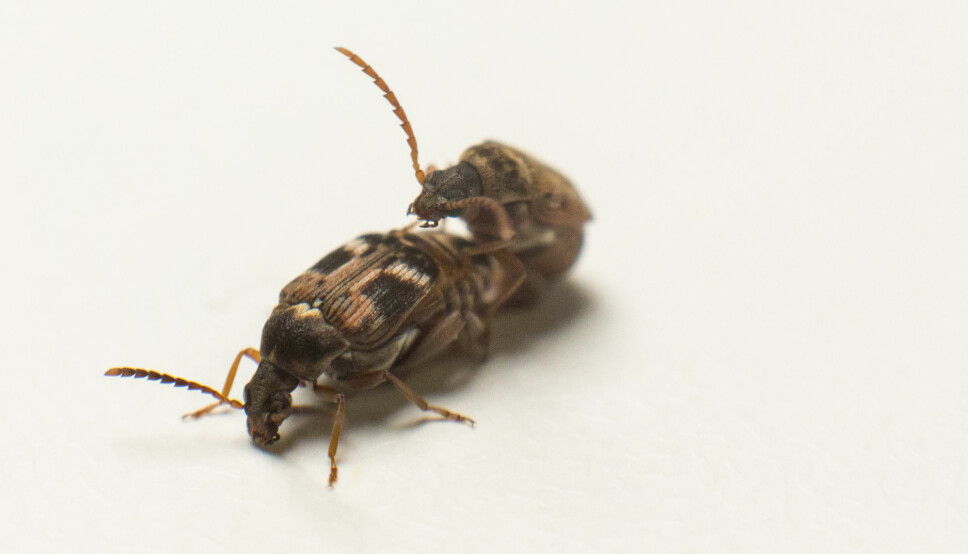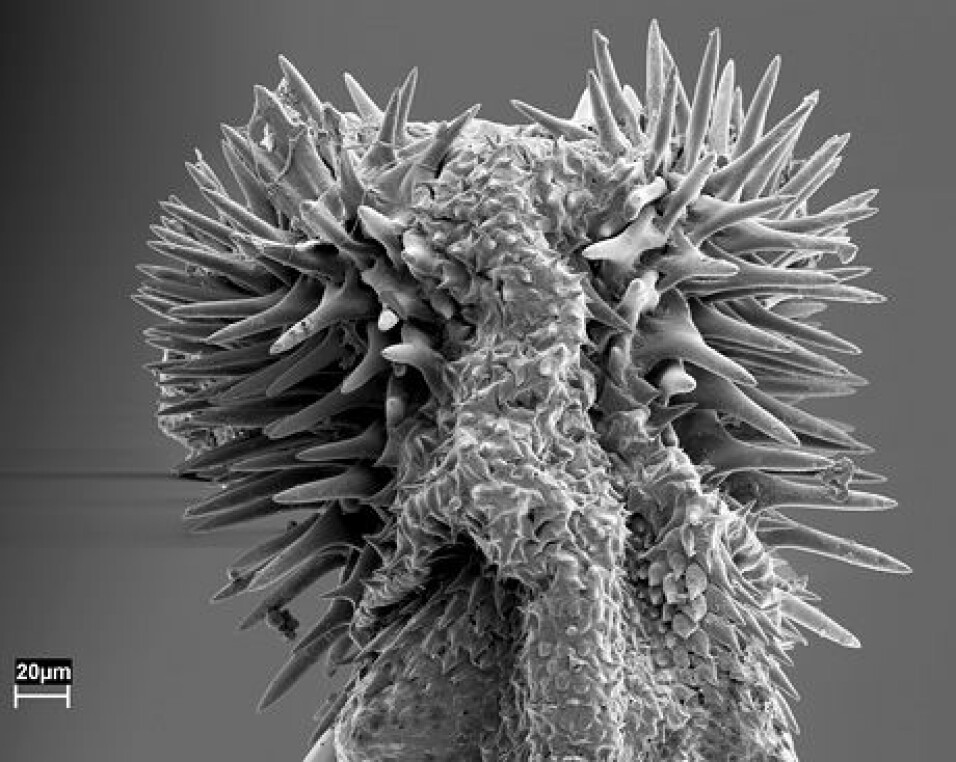
What happens to a species when it becomes more important to reproduce than to survive?
Researchers fiddled with how seed beetles were allowed to mate. The experiment showed that when the competition between the males becomes too strong, their offspring end up with more mutations.
What do peacocks, capercaillie and moose have in common? They have all developed traits that neither protect them from natural enemies nor help them obtain food.
The ornamental tails and antlers of the males have no function other than to win in the fight to mate with the females.
The same trait applies to the seed beetle Callosobruchus maculatus. These pests, which lay eggs on legumes, are many scientists’ favourites. They are easy to keep alive in the laboratory and multiply quickly. And the male beetles have to compete fiercely for the opportunity to become fathers.
Swedish researchers have now investigated what happens when they tamper with the natural mating of these seed beetles. While some beetles had to compete for who was allowed to mate, others were forced to be monogamous.
The study could help to explain the benefits of sexual selection – but also its disadvantages.
Monstrous penis
In their natural surroundings, female seed beetles of this particular species lay eggs on legumes. The hatched larvae feed on the interior of the seed until they are adequately nourished to pupate and undergo their final transformation into beetles.
When the seed beetles emerge from their eggs, they don’t require food or water. At that point, only one thing matters, says Lisa Fagerli Lunde. She is an insect researcher at the Norwegian University of Life Sciences (NMBU).
The males pursue the females to reproduce. When the male beetle grabs hold, it’s not a particularly pleasant experience for the female beetles, the researcher says. The males have penile spikes that injure the female during mating.

“It’s believed that sexual selection has caused these males to develop a monstrous penis that resembles a morning star – a club-like weapon from the Middle Ages adorned with spikes,” says Lunde.
In addition, up to five per cent of the body weight of these seed beetles consists of sperm, according to the insect researcher. On a human scale, that would mean that a man of 100 kilograms would be carrying five litres of sperm around all the time.

Having a lot of sperm is advantageous for male beetles because the competition to become a father mainly takes place inside the beetle.
Paradoxical evolution
The result is that only the male seed beetles with the most and best sperm succeed at passing on their genes to the next generation.
And this is one of the paradoxes of sexual selection. Biologists call it the lek paradox, named after the courtship displays that some species, such as capercaillie, do to compete for who gets to mate.
The result is that when there is stiff competition between the males of a species, only a few male individuals are given the opportunity to pass on their genes. The males that come out on top can mate with many females, whereas others may not reproduce at all.
In theory, strong sexual selection can lead to less genetic variation in a species. If only a few males have the chance to spread their genes, then more offspring will have more similar traits and less genetic variation. This could cause a species to become very vulnerable to environmental changes.
Hypothetically then, the fierce sperm competition for these seed beetles could be devastating for the species.
But Swedish researchers have shown this not to be the case.
Multiple mutations in the sperm
The researchers found that the offspring of the beetles that had to compete with each other have several mutations in their DNA.
This finding is in line with previous theories and may help to explain how the species can maintain its genetic variation.

Arild Johnsen does research on sexual selection at the Natural History Museum at the University of Oslo. He notes that even asexual species have evolved, and this is mainly due to mutations.
"Mutations are one of the most important sources of genetic variation and a prerequisite for the development of viruses, bacteria and other life," says the evolutionary biologist.
He points to the coronavirus, which has already mutated many times over. The mutations can give the virus new properties.
For the beetles, the mutations in the sperm can ensure that the genetic variation of the species is maintained – despite the fact that only a few males pass on their genes.
The Swedish study does not explain how the mutations occur. But the researchers show that the competing male beetles produce more sperm than the beetles that remain monogamous.
Mutations can occur when sperm develop inside the body.
In order to produce sperm, a lot of cells have to divide in a particular way. After all, sex cells only contain half the chromosomes of normal cells. In this process, major or minor chromosome errors can readily occur.
Fewer mutations in the long term
But many mutations can also be harmful to the species. At worst, they can cause serious genetic errors in the offspring and their offspring, which means they don't survive long enough to reproduce.
Nevertheless, the Swedish researchers' experiment shows that beetles that have to compete to mate manage well over successive generations.
The experiments indicate that the winning males are ones that have good genes and succeed in correcting the errors in their DNA over time, according to the researchers.
The beetles that reproduced using sexual selection had fewer mutations over many generations than those beetles that the researchers did the pairing for.
David Berger at the University of Uppsala is one of the researchers behind the study. He stated in a press release that in the long term, beetles acquire better genetic health from the intense competition between the sperm of the males.
"Although the direct effect of the sperm competition is to increase the number of new mutations in the offspring, the long-term effect of sexual selection may paradoxically lead to lower mutation rates," says Berger.
Mutations not measured directly
Arild Johnsen researches sexual selection in birds rather than in beetles. He says that the lek paradox is an enigma that evolutionary biologists have been working on for a long time.
The new seed beetle study is interesting, says Johnsen. At the same time, he is sorry it does not offer clearer answers to what is really going on with these beetles.
In their study, the Swedish scientists don’t measure the beetles’ actual DNA to find out how many mutations they have. Instead, they expose the beetles to radiation and see how well they manage to reproduce afterwards.
Radiation causes mutations in the DNA. So the idea behind the radiation is that specimens that already have numerous mutations will be less able to withstand the radiation, the researchers say.
“It's a shame they couldn't measure the mutations more directly with genetic analysis,” says Johnson. Their method is valid, because most likely it does have to do with mutations. But I’d like to see the study use more direct measurements.”
Peacocks made Darwin nauseous
At the same time, Johnsen emphasizes that sexual selection is neither new nor contradictory to classical evolutionary theory.
Many of us probably associate evolutionary theory with “survival of the fittest” – natural selection, in other words – like the textbook example of the moths in the UK that went from being white to black during the industrial revolution. Being black was an advantage for the moths because the birch trees that they used to hide from birds became covered with soot.
At the start of his career, Darwin also struggled to explain why some species had traits that did not help them survive, according to Johnsen.
“Darwin wrote in a letter that he got nauseous every time he saw a peacock's tail. Not because he didn't like it, but because he couldn't explain it,” says Johnsen.
Later he presented theories of sexual selection that still hold water today, according to Johnsen.
“Evolution isn’t just about ‘survival of the fittest,’ but also ‘reproduction of the fittest,’” says Johnsen.
The seed beetle Callosobruchus maculatus is a good example.
Translated by: Ingrid P. Nuse
Reference:
Julian Baur and David Berger: Experimental evidence for effects of sexual selection on condition-dependent mutation rates, Nature Ecology & Evolution, https://doi.org/10.1038/s41559-020-1140-7
———































